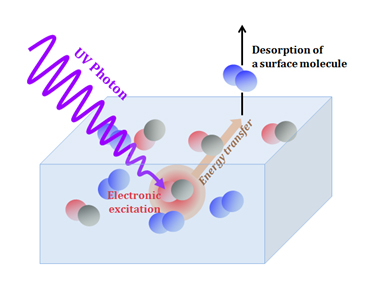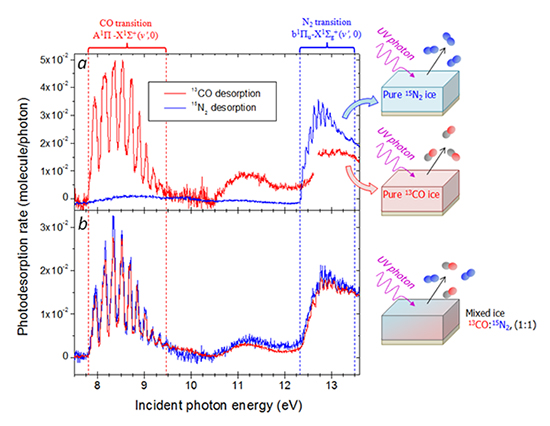In the very cold regions of the interstellar medium (10-30 K), desorption induced by low-energy (7-14 eV) UV photons can explain the abundances of molecules in the gas phase, at temperatures well-below their condensation threshold onto dust grains. The first systematic study of condensed films consisting of CO: N2 mixtures, carried out using the DESIRS beamline, provides first evidence of a very efficient indirect desorption process. This phenomenon reveals an energy transfer from the excited molecules towards the surface, which explains why desorption of non-absorbing chemical species can be observed. This indirect effect, which was not well known until now, could contribute to a better understanding of the gas-to-ice abundance ratio of molecules in star forming regions.

The experimental method is based on the recording of photon-induced desorption spectra, developed via the SPICES experiment performed by LPMAA (a laboratory at Pierre and Marie Curie University) combined with the DESIRS beamline. The irradiation of pure ice films (15 ML, 10 K) between 7 and 14 eV shows desorption induced by electronic transitions, which is very efficient below 10 eV for CO (figure 2a in red) and very efficient above 12 eV for N2 (figure 2a in blue). In a homogeneous CO:N2 mixture, however, both species desorb in an identical manner (figure 2b). In particular, we note that N2 is photo-desorbed below 10 eV via the absorption of radiation by CO, whilst CO is photo-desorbed below 12 eV via electronic transitions in the nitrogen. This study shows that photodesorption results from the cumulative effect of both species, and the efficiency of the phenomenon is strongly dependent on the homogeneity of the film. In view of the very likely layered structure of the interstellar ice, this result could be the cause of differentiation of the species, and could explain the abundance anomalies of some nitrogen-bearing species observed in pres-stellar cores.

